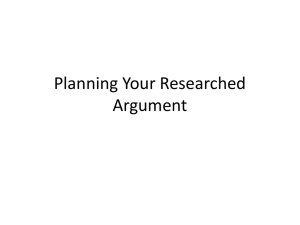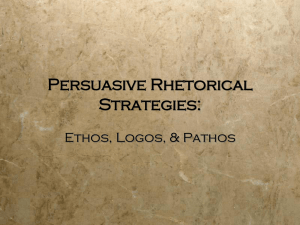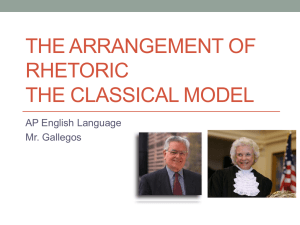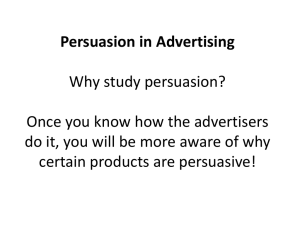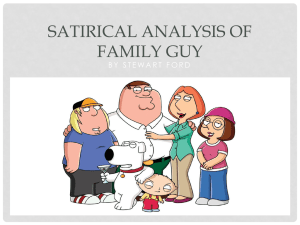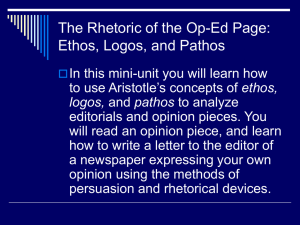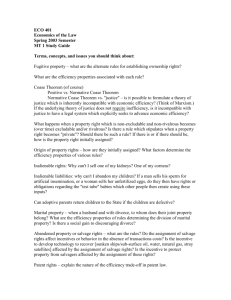Aristotle
advertisement
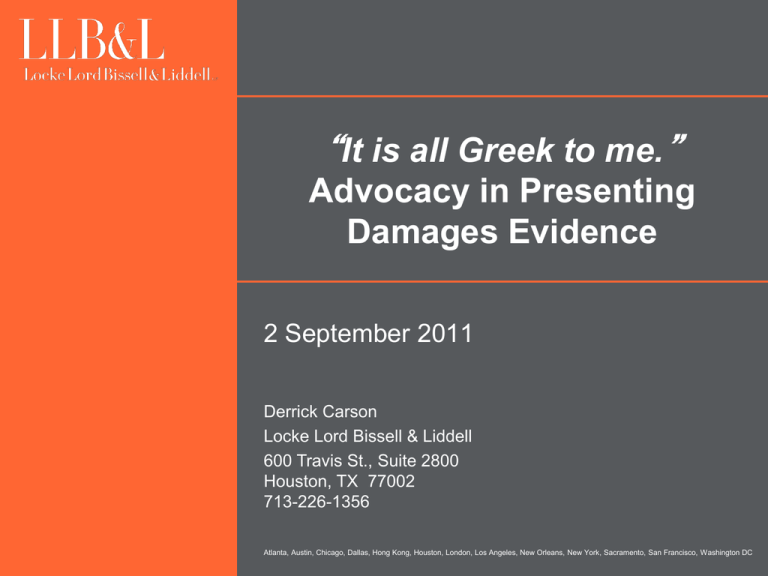
“It is all Greek to me.” Advocacy in Presenting Damages Evidence 2 September 2011 Derrick Carson Locke Lord Bissell & Liddell 600 Travis St., Suite 2800 Houston, TX 77002 713-226-1356 Atlanta, Austin, Chicago, Dallas, Hong Kong, Houston, London, Los Angeles, New Orleans, New York, Sacramento, San Francisco, Washington DC Some things never change . . . Aristotle: “To be willing to go to arbitration rather than to a diskasterion; because the arbitrator looks to equity but the dikast to the legal rule. It was for this reason that an arbitrator was chosen, so that equity would prevail.” Some things never change . . . Even the Romans agreed . . . Cicero: “We come before the court with the expectation that we shall either win or lose the whole case; but we submit to an arbitrator on the understanding that we shall end up neither with nothing nor as much as we asked for.” Modes of Persuasion Aristotle’s On Rhetoric describes persuasion occurring in three ways: •by the speaker's personal character when the speech is so spoken as to make the listeners think him credible (ethos) •by the listeners when the speech stirs their emotions (pathos) •by the speech itself when its logic is irrefutable (logos) Practical Applications for Presenting Damages Evidence Damages are the case. Every aspect of the case must be leading toward the damages. •The theory of the case •The claims asserted •The witnesses chosen to give evidence •The manner in which the evidence is selected and presented •Demonstrative exhibits Examples of Practical Applications Pathos – Not just emotion, but an appeal to sympathies, sense of fairness, and imagination •The theory of the case •The position of your client in the narrative •Story telling in the presentation of evidence Examples of Practical Applications Ethos – Not just moral, but knowledgeable and experienced as well •The Theory of the Case •Selection of witnesses •What evidence you want various witnesses to give Examples of Practical Applications Logos – Well reasoned argument is the foundation of a damages case. •Theory of the case •Order of presenting evidence •Selection of evidence Theory of the Case Basic narrative around which everything else in the case revolve. • Legal claims advance the theory • Theory fits the factual background • Evidence presented is consistent with the theory • The theory leads to the damages claimed Theory of the Case • Ethos: Why is your client’s story credible? – Source / identity – Content • Pathos: Is it consistent with the overriding values? – Community – Industry • Logos: Does the theory make sense? – Internally consistent Aristotle on Damages Experts Ethos • Qualified, respected • Renders only (1) necessary and (2) supportable opinions “like the 13th stroke of a clock, not only wrong in itself but casting doubt on all that preceded it.” (Scalia & Garner) Aristotle on Damages Experts Pathos • Descriptive, illustrative language • Consistent with the pathos of the theory of the case Aristotle on Damages Experts Logos • Internally consistent • Supported by the evidence • Consistent with the theory of the case Qualities of a Good Damages Expert • Qualified, knowledgeable, experienced in the subject matter • Able to assume a “teacher” persona • Understands your theory of the case (or can help you shape a new one) • Independent, will “push-back” • Able to commit adequate time to your case • Willing to provide and hold to a budget Choosing a Damages Expert • • • • • Know your audience Require the expert to make a self-disclosure Thoroughly research your expert In-person interviews are a must Prior experience as an expert – necessarily a good thing? • Use of in-house expertise? Preparing the expert The Woodshed Preparing the expert Mock Cross-Examination •Purpose is not to change the witness’s testimony, but to ensure she is prepared to delivery her testimony effectively •Have a colleague conduct the cross-x •Be unfair (practice harder than the game) •Cover all points of likely examination 17 Preparing the expert How to prepare for “Hot Tubbing”? •Witness must remain calm, professional •Witness must be comfortable with what he should concede •Witness should be prepared with clear speaking points to likely questions •Witness should be armed with questions for the opposing expert 18 Presenting the expert Six S’s for Effective Expert Presentation: 1.Sequence 2.Speak in plain terms 3.Share the burden 4.Simplify 5.Storytelling 6.Show, don’t just tell Presenting the expert Sequence – CARS •Conclusion •Analysis / Support •Refutation “[I]n court one must begin by giving one’s own proofs, and then meet those of the opposition by dissolving them and tearing them up before they are made.” Aristotle •Summation Cross-Examining the Expert • Challenge the expert’s “facts” – “Experts are professional explainers. Their opinions are no more reliable than the facts their based on.” James McEllaney • Challenge methodology/assumptions • Change the question the witness answers • Use the opposing expert to bolster your own 21

